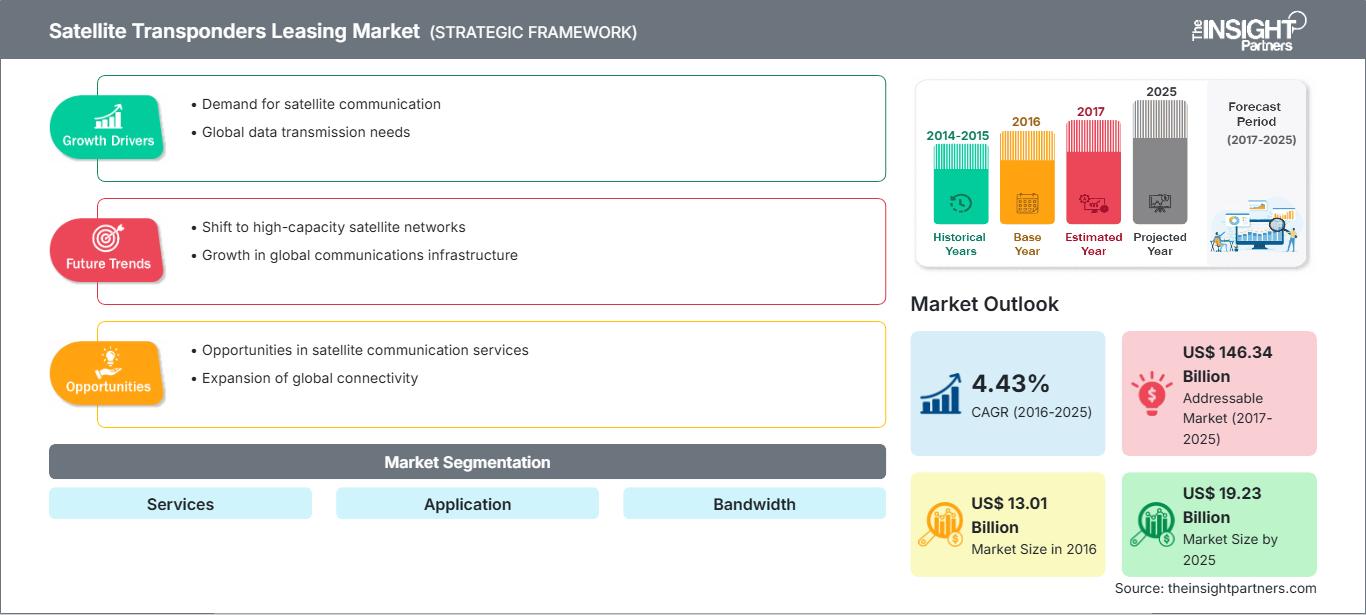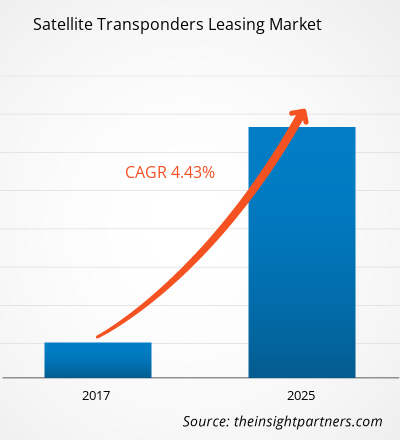Se espera que el mercado de arrendamiento de transpondedores satelitales crezca de US$ 13.010 millones en 2016 a US$ 19.230 millones en 2025, a una CAGR del 4,43% entre 2016 y 2025.
Se prevé que el mercado de alquiler de transpondedores satelitales crezca tanto en cobertura como en capacidad, ya que las frecuencias de las bandas Ka y Ku impulsarán dicho crecimiento. Además, se espera que el creciente número de actualizaciones y nuevos suscriptores impulse el mercado global de transpondedores satelitales. Asimismo, gracias a los avances tecnológicos actuales en las comunicaciones por satélite, se prevé el surgimiento de nuevas aplicaciones para los transpondedores satelitales. Se considera que estos satélites son lo suficientemente potentes como para competir con su competidor, la banda ancha de línea de abonado digital (DSL), en términos de rendimiento. Se espera que todos estos factores impulsen el mercado global de alquiler de transpondedores satelitales durante el período de pronóstico.
Perspectivas del mercado
La expansión de las aplicaciones en banda Ku generará nuevas oportunidades para el mercado de alquiler de transpondedores de satélites de comunicaciones
La transmisión en vivo y la distribución de video son algunas de las principales aplicaciones de los satélites de banda Ku. Además, se utilizan para diversos servicios de datos, como servicios VSAT, conectividad de banda ancha, backhaul móvil, servicios aeronáuticos y marítimos. En este mundo altamente conectado, todas estas aplicaciones se consideran cruciales para el funcionamiento de una empresa. De hecho, la banda Ku es el principal espectro utilizado por las redes de movilidad para brindar conectividad de banda ancha en áreas donde las redes terrestres no llegan, es decir, sobre el océano y la troposfera. La banda Ku abarca aproximadamente el 40% del mercado en términos de ancho de banda. Se prevé que la demanda de transpondedores de banda Ku aumente debido a la creciente popularidad de la televisión por satélite, especialmente en las economías en desarrollo, impulsada además por la alta definición (HD) y la demanda de otras aplicaciones de ancho de banda similares. Se espera que la evolución de los canales 3D, que consumen mayor ancho de banda y requieren un 50% más de capacidad, impulse el mercado de transpondedores satelitales de banda Ku. Le siguen los transpondedores de banda C, que actualmente ostentan la mayor cuota de mercado, pero se prevé una caída constante durante el período de pronóstico, perdiendo protagonismo frente a la banda Ku y otros anchos de banda similares. Por lo tanto, se espera que esta expansión de las aplicaciones de banda Ku genere nuevas oportunidades para el mercado de alquiler de transpondedores satelitales.
El arrendamiento de transpondedores como servicio dominará el segmento de servicios globales del mercado de arrendamiento de transpondedores satelitales.
En los últimos uno o dos años, el mercado global de transpondedores satelitales ha experimentado un aumento aproximado del 4,3% al 4,5% en la demanda de transpondedores arrendados. Se prevé que este aumento se incremente aún más debido al aumento exponencial del costo de los transpondedores a nivel mundial. En cuanto al mercado de arrendamiento de transpondedores satelitales, Europa se destaca como la región más costosa, seguida de Australia y Nueva Zelanda. Mientras que el sur de Asia ofrece las tarifas de arrendamiento más bajas, por lo que Asia Pacífico se considera la región más prometedora para el mercado de arrendamiento de transpondedores satelitales en los próximos años. Recientemente, la compañía coreana de satélites KT SAT firmó un acuerdo de arrendamiento de transpondedores con un operador de televisión satelital mongol. El proveedor de servicios KT SAT ha acordado el arrendamiento de cuatro transpondedores, lo que cumplirá con el propósito de ofrecer servicios DTH a las compañías mongolas que se iniciarán el próximo año. Se prevé que la compañía DDISH TV se beneficie de los servicios de KT SAT en 2017. El arrendamiento de transpondedores satelitales de comunicaciones depende en gran medida de la adopción de la transmisión de video HD y de la expansión de las aplicaciones de alto rango dinámico (HDR). No obstante, se espera que los servicios de arrendamiento lideren el mercado de arrendamiento de transpondedores satelitales con una cuota de mercado relativamente alta, sujeta a fluctuaciones en función de la revisión del costo de adquisición de los transpondedores satelitales y del costo total de lanzamiento y mantenimiento de un satélite.
Obtendrá personalización en cualquier informe, sin cargo, incluidas partes de este informe o análisis a nivel de país, paquete de datos de Excel, así como también grandes ofertas y descuentos para empresas emergentes y universidades.
Mercado de arrendamiento de transpondedores satelitales: Perspectivas estratégicas

-
Obtenga las principales tendencias clave del mercado de este informe.Esta muestra GRATUITA incluirá análisis de datos, desde tendencias del mercado hasta estimaciones y pronósticos.
La iniciativa de mercado se consideró la estrategia más adoptada en el mercado global de arrendamiento de transpondedores satelitales. A continuación, se enumeran algunas de las estrategias recientes de algunos actores del mercado de arrendamiento de transpondedores satelitales:
- 2016: GlobalSat otorga licencias para servicios de banda L y Ka de Inmarsat en todo México
- 2016: MVS USA actualiza su red de comunicaciones por satélite con la mira puesta en la ciberseguridad
- 2016: O3b y Ozonio llevan banda ancha a otra ciudad amazónica de Brasil
- 2016: Las escuelas africanas se beneficiarán del nuevo acuerdo entre Gazprom y Gilat
- 2016: Indonesia construye acceso de banda ancha en zonas desatendidas con Newtec
Perspectivas regionales del mercado de arrendamiento de transpondedores satelitales
Los analistas de The Insight Partners han explicado detalladamente las tendencias y los factores regionales que influyen en el mercado de arrendamiento de transpondedores satelitales durante el período de pronóstico. Esta sección también analiza los segmentos y la geografía del mercado de arrendamiento de transpondedores satelitales en América del Norte, Europa, Asia Pacífico, Oriente Medio y África, y América del Sur y Central.
Alcance del informe sobre el mercado de arrendamiento de transpondedores satelitales
| Atributo del informe | Detalles |
|---|---|
| Tamaño del mercado en 2016 | US$ 13.01 mil millones |
| Tamaño del mercado en 2025 | US$ 19.23 mil millones |
| CAGR global (2016-2025) | 4,43% |
| Datos históricos | 2014-2015 |
| Período de pronóstico | 2017-2025 |
| Segmentos cubiertos | Por serviciosPor aplicaciónPor ancho de banda |
| Regiones y países cubiertos |
América del norte
|
| Líderes del mercado y perfiles de empresas clave |
|
Densidad de actores en el mercado de arrendamiento de transpondedores satelitales: comprensión de su impacto en la dinámica empresarial
El mercado de arrendamiento de transpondedores satelitales está creciendo rápidamente, impulsado por la creciente demanda de los usuarios finales debido a factores como la evolución de las preferencias de los consumidores, los avances tecnológicos y un mayor conocimiento de las ventajas del producto. A medida que aumenta la demanda, las empresas amplían su oferta, innovan para satisfacer las necesidades de los consumidores y aprovechan las tendencias emergentes, lo que impulsa aún más el crecimiento del mercado.

- Obtenga una descripción general de los principales actores clave del mercado de arrendamiento de transpondedores satelitales
Arrendamiento global de transpondedores satelitales: Segmentación del mercado
Por Servicios
- Protegido
- Desprotegido
- Preemptable
Por aplicación
- Gobierno y ejército
- Telecomunicaciones
- Comercial
- Investigación y desarrollo
- Navegación
- Teledetección
Por ancho de banda
- Banda Ku
- Banda Ka
- Banda C
- Otros (S, L, X y K)
Por geografía
-
América del norte
- A NOSOTROS
- Canadá
- México
-
Europa
- Rusia
- Francia
- Alemania
- Reino Unido
- Luxemburgo
- Resto de Europa
-
Asia Pacífico (APAC)
- Porcelana
- India
- Japón
- Resto de APAC
-
Oriente Medio y África (MEA)
- Arabia Saudita
- Sudáfrica
- Israel
- Emiratos Árabes Unidos
- Resto de MEA
-
América del Sur (SAM)
- Brasil
- Argentina
- Resto de SAM
Perfiles de empresas
- Intelsat
- SES
- Eutelsat
- Telesat
- SingTel Optus
- Sistemas satelitales MEASAT
- Satélite de transmisión asiática
- Arabsat
- ISRO
- Compañía de comunicaciones por satélite de China.
- Análisis histórico (2 años), año base, pronóstico (7 años) con CAGR
- Análisis PEST y FODA
- Tamaño del mercado, valor/volumen: global, regional y nacional
- Industria y panorama competitivo
- Conjunto de datos de Excel
Informes recientes
Testimonios
Razón para comprar
- Toma de decisiones informada
- Comprensión de la dinámica del mercado
- Análisis competitivo
- Información sobre clientes
- Pronósticos del mercado
- Mitigación de riesgos
- Planificación estratégica
- Justificación de la inversión
- Identificación de mercados emergentes
- Mejora de las estrategias de marketing
- Impulso de la eficiencia operativa
- Alineación con las tendencias regulatorias






















 Obtenga una muestra gratuita para - Mercado de arrendamiento de transpondedores de satélite
Obtenga una muestra gratuita para - Mercado de arrendamiento de transpondedores de satélite